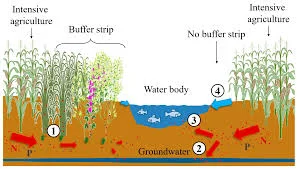
Why in News?
- The Indian government is taking a crucial step towards a greener future by exploring the potential of biomass cultivation on degraded land.
- This initiative holds immense promise for not only generating clean bioenergy but also for restoring ravaged ecosystems and bolstering rural livelihoods.
Unearthing the Potential: Key Highlights of the Meeting
- A recent meeting convened by the Principal Scientific Adviser (PSA) to the Government of India brought together key stakeholders to discuss this groundbreaking initiative. Here are some of the key takeaways from this meeting:
- Seaweed Cultivation: Experts highlighted the exciting prospects of seaweed cultivation as a viable source of biomass for bioenergy production. This approach has the potential to foster a thriving marine biomanufacturing ecosystem, creating new economic opportunities.
- Plant-Based Biomass Options: Discussions revolved around exploring various plant-based sources for biomass production, including algae, molasses, and sugarcane. Identifying a diverse range of feedstock options will enhance the overall sustainability and resilience of the initiative.
- Government Programs and Data Utilization: The meeting emphasized the National Green Hydrogen Mission’s focus on initiating pilot projects for biomass-based green biohydrogen production. Additionally, the Ministry of New & Renewable Energy (MNRE) highlighted existing programs promoting bioenergy and the National Biomass Atlas, a valuable tool for understanding agri-residue surplus data across the country.
- Economic and Strategic Frameworks: Data on biomass availability from degraded land and agri-residue is crucial for project success. The National Remote Sensing Centre (NRSC) and Indian Space Research Organisation (ISRO) showcased the Bhuvan portal, a platform providing insights into biomass availability. Characterization data on the biomass itself is also essential for understanding its potential for biofuel production.
What is Biomass Cultivation on Degraded Land?
- Biomass cultivation on degraded land refers to the practice of growing organic matter, such as crops or trees, on land rendered unsuitable for conventional agriculture due to factors like soil erosion, salinization, or deforestation. it is , a renewable resource derived from plants and animals, holds immense potential for bioenergy generation.
Reaping the Benefits: Why is Biomass Cultivation on Degraded Land Significant?
- This innovative approach offers a multitude of benefits:
- Soil Restoration and Erosion Prevention: Cultivating energy crops on degraded land helps rebuild and improve soil quality, fertility, and structure. This not only prevents further soil erosion but also creates a habitat for native plant species. This restoration process contributes significantly to biodiversity conservation and acts as a natural carbon sink, mitigating climate change.
- Carbon Sequestration: Biomass plants absorb carbon dioxide from the atmosphere during photosynthesis, playing a vital role in combating climate change.
- Sustainable Biohydrogen Production: Biomass can be used as a feedstock for green biohydrogen production through thermochemical or biochemical conversion processes. Green biohydrogen is a clean-burning fuel that produces only water vapor as an emission.
- Bioenergy Generation: Degraded or barren land can be effectively utilized for cultivating bioenergy crops like fast-growing trees, grasses, and other plants with high energy content. The resulting biomass can then be converted into various forms of bioenergy, such as biofuels, biogas, or solid biomass.
- Enhancing Food Security: By focusing biomass cultivation on degraded lands, fertile agricultural land is preserved for growing food crops. This strategy prevents the diversion of food resources and strengthens food security while also promoting agricultural exports.
India’s Biomass Potential: A Land of Opportunity
- India’s robust agricultural sector, a significant contributor to the country’s GDP and a source of livelihood for over half of its population, presents a unique advantage for sustainable energy production.
- Agricultural residues offer a sustainable and carbon-neutral solution with the potential to generate significant income opportunities.
- A recent study by the MNRE estimates a surplus availability of approximately 230 million metric tonnes per annum from agricultural residues, with a potential power generation capacity of 28 GW for the country.
Challenges and the Way Forward: Cultivating a Sustainable Future
- Despite the immense potential, cultivating crops on degraded land presents some challenges:
- Soil Quality : Degraded land often lacks essential nutrients and organic matter. Implementing strategies like incorporating organic compost, biochar, or utilizing bioflocculation techniques to improve soil health is crucial for successful cultivation.
- Species Selection and Adaptation: Selecting suitable crops that can thrive in harsh conditions is essential. Research efforts should focus on identifying resilient species and improving their adaptability to withstand extreme temperatures, droughts, or floods.
- Water Availability and Management: Degraded land often faces water scarcity. Developing efficient irrigation methods for crops and exploring rainwater harvesting techniques are crucial for ensuring sustainable water management.
- Economic Viability and Market Demand : Initial investments in land preparation, seedlings, and infrastructure can be substantial. Establishing a strong market demand for crops and their byproducts is essential for economic viability.
People also ask
Q1: What is the significance of the recent meeting on biomass cultivation on degraded land?
Ans: This meeting brought together key stakeholders to discuss the potential of using degraded land for growing biomass for bioenergy and green hydrogen production. It highlighted ongoing government programs, data resources, and the need for further research.
Q2: What are the different types of biomass feedstock options being explored?
Ans: The focus is not just on traditional options like plants used for biofuels. The meeting discussed possibilities like seaweed cultivation for bioenergy and exploring various plant-based sources like algae, molasses, and sugarcane.
Your article helped me a lot, is there any more related content? Thanks!
Thank you for your sharing. I am worried that I lack creative ideas. It is your article that makes me full of hope. Thank you. But, I have a question, can you help me?
Thank you for your sharing. I am worried that I lack creative ideas. It is your article that makes me full of hope. Thank you. But, I have a question, can you help me?